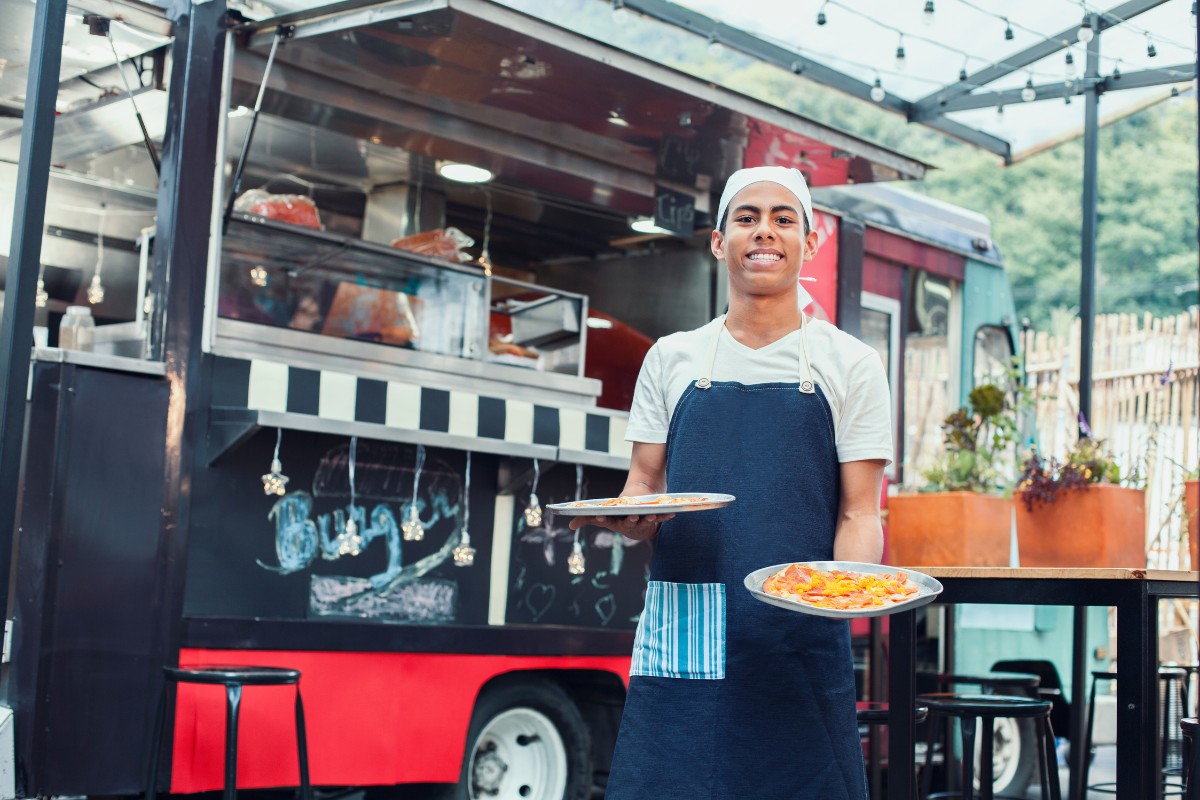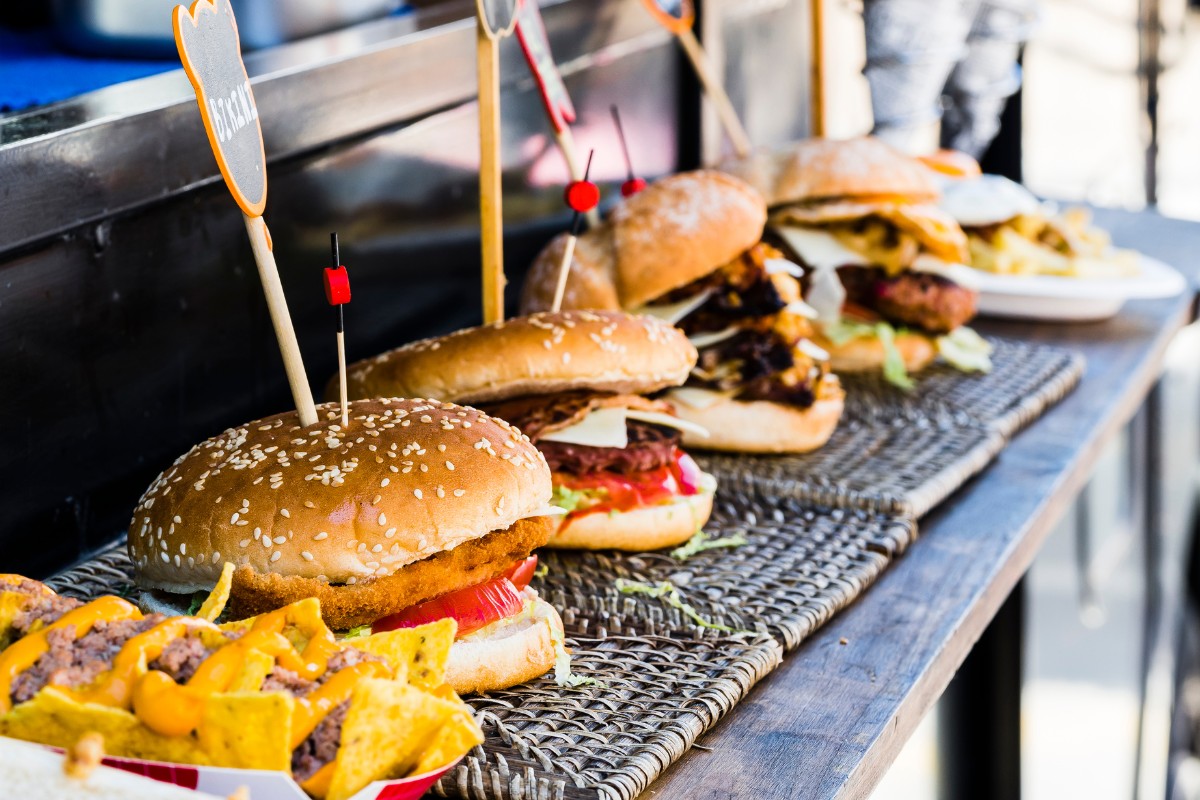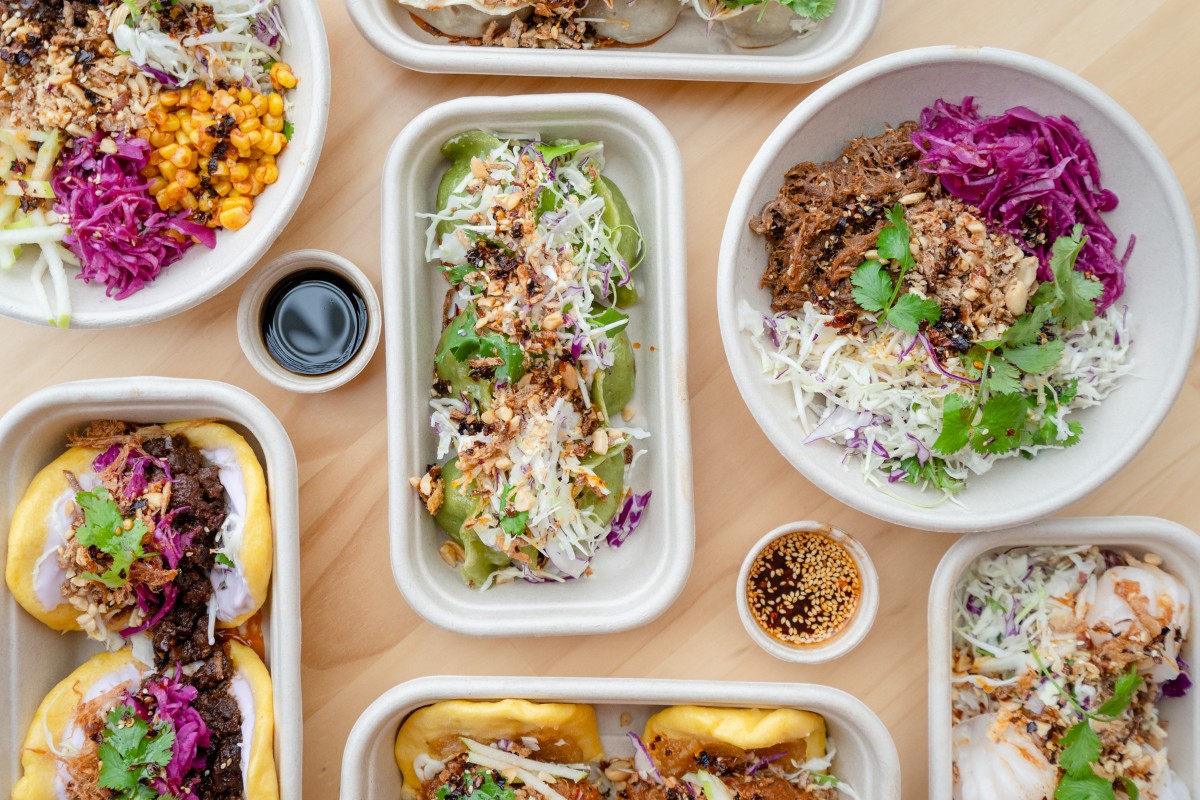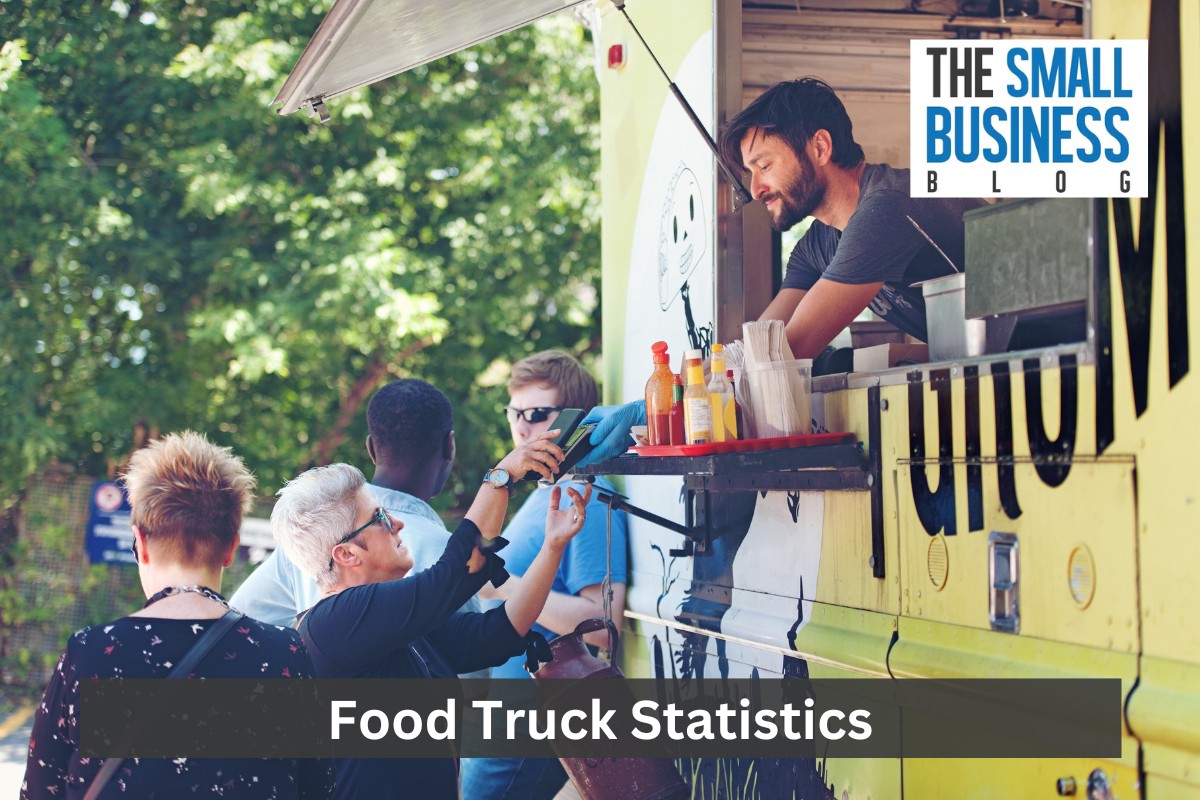The first food trucks were called chuck wagons that were used to service cowboys and loggers in the wilderness of America.
In this resource, we will address modern-day food trucks through food truck statistics.
After the chuckwagon of the early 1800s, Oscar Meyer’s wiener truck, the “Wienermobile” (circa 1936) toured the U.S. advertising their brand by selling hot dogs at parades, hospitals, schools, etc.
Since then, food trucks have had their difficulties, but today, they are almost essential for restaurants and cafes to sell food, meals, and beverages by taking it to the people.
They are also used as an alternative to a standalone restaurant or cafe to lower overhead.
Let’s look at how food trucks have evolved in modern times and what the future may hold.
Post Contents
- 1 Key Statistics
- 2 Top Food Truck Statistics in 2024
- 2.1 1. In the United States there are 36,324 food trucks as of 2023.
- 2.2 2. It can cost an average of $28,276 to get the proper permits for a food truck business.
- 2.3 3. The food truck industry has grown by 12% yearly since 2016.
- 2.4 4. Successful food trucks can earn between $250,000 to $500,000 annually.
- 2.5 5. 43.40% of food truck customers are aged 25 to 44.
- 2.6 6. 76% of food truck cooks are male.
- 2.7 7. 80% of mobile kitchen patrons say it’s a fun experience.
- 2.8 8. The number one city for food trucks in the United States is Portland, Oregon.
- 2.9 9. The state with the most food trucks in American is California.
- 2.10 10. 30% of food truck chefs have at least a high school diploma.
- 2.11 11. The food truck industry employs over 40,000 people in 2022.
- 2.12 12. Hamburgers are the most favorite item on a food truck menu.
- 2.13 13. The overall success rate for food truck businesses is 40%.
- 2.14 14. The food truck industry is overtaking the restaurant market by 5.5% and 4.3%.
- 2.15 15. 78% of all American consumers buy food from a food truck at least once per month.
- 3 Global Food Truck Industry Statistics
- 3.1 16. In the Netherlands, food truck numbers went from 1200 to 2500.
- 3.2 17. The global food truck market is expected to grow by 6.8% (CAGR) between 2021 and 2028.
- 3.3 18. North America owns the largest share in the global food truck market in 2023 at 30.10%.
- 3.4 19. In 2020, Europe accounted for 29% of the global food truck market.
- 3.5 20. The Asia Pacific food truck industry growth is expected to grow at a 7.5% CAGR between 2021 and 2028.
- 4 FAQs
- 5 Conclusion
Key Statistics
- In the United States there are 36,324 food trucks as of 2023.
- It can cost an average of $28,276 to get the proper permits for a food truck business.
- The food truck industry has grown by 12% yearly since 2016.
- Successful food trucks can earn between $250,000 to $500,000 annually.
- 43.40% of food truck customers are aged 25 to 44.
- 76% of food truck cooks are male.
- In the Netherlands, food truck numbers went from 1200 to 2500.
- The global food truck market is expected to grow by 6.8% (CAGR) between 2021 and 2028.
- North America will have the largest share in the food truck market in 2023.
- The Asia Pacific food truck industry growth is expected to grow at a 7.5% CAGR between 2021 and 2028.
Top Food Truck Statistics in 2024

1. In the United States there are 36,324 food trucks as of 2023.
In the United States alone, you will find 36,324 unique food trucks in 2023.
This is a rise of 9.9% over the number of food trucks in 2022 and 2023 still has several months left.
The overhead is lower with a food truck than for a restaurant.
Plus, you don’t need furniture, special decorations, or the standard expenses that come with restaurant ownership.
(IBISWorld, LinkedIn)
2. It can cost an average of $28,276 to get the proper permits for a food truck business.
When considering starting a business, cost is one of the biggest things that people explore.
Due to stricter laws, rules, and regulations related to food trucks, permits come at a high cost.
Always be sure to check how much it costs where you live to start a food truck business.
(Zippia)
3. The food truck industry has grown by 12% yearly since 2016.
How’s the food truck industry doing? It’s been growing by 12% since 2016.
Due to the lower startup and overhead costs of owning a food truck business, it’s not surprising that so many people are getting into it.
Plus, it offers more flexibility than brick-and-mortar businesses.
(Chef’s Store Industry Food Truck Report 2022)
4. Successful food trucks can earn between $250,000 to $500,000 annually.
The most successful food truck vendors can earn between $250,000 to $500,000 in sales per year.
Statistics show that 30% of food truck owners earn between $150,000 and $190,000 per year.
However, only 10% earned between $50,000 to $99,999 annually and 4% under $50,000 per year.
(Chef’s Store Industry Food Truck Report 2022, EnterpriseAppsToday)
5. 43.40% of food truck customers are aged 25 to 44.
In terms of customers by age, those aged 25 to 44 account for 43.40% of food truck patrons.
This accounts for the largest share of customers for food trucks.
The next highest age consists of those who are under 25 at 19.70%.
For those 55 years and older, 19.20% of them visit food trucks.
The age demographic between 45 and 54 visit food trucks the least at 17.70%.
(EnterpriseAppsToday)
6. 76% of food truck cooks are male.

Interestingly enough, 76% of food truck cooks are men and 24% are women, which is quite the gender gap.
Remember that food truck owners choose to engage in the food truck industry.
Therefore, many of them are likely to do the cooking themselves at least for a time before hiring new employees.
Also, it’s not unusual for family and friends to work together in this industry.
(Gitnux)
7. 80% of mobile kitchen patrons say it’s a fun experience.
According to research, 80% of customers who visit food trucks say it’s a fun and exciting experience.
Customers play a vital role in the success or failure of any business, but this is especially true when it’s a mobile kitchen deal.
It helps to have gluten and grain free alternatives, plant-based options, sustainable foods, or a menu of global foods.
(Chef’s Store Industry Food Truck Report 2022)
8. The number one city for food trucks in the United States is Portland, Oregon.
Data shows that Portland, Oregon is the best place for food trucks in America.
This city/state offers the lowest restrictions and yearly permit fees over all others in the country.
Other cities that enjoy high food truck ownership include Denver, Colorado, Orlando, Florida, Philadelphia, Pennsylvania, and Nashville, Tennessee.
(Zippia)
9. The state with the most food trucks in American is California.
California is the state with the most food trucks with 753 food truck businesses in operation.
Texas is second with 549 food truck operators and Florida is behind Texas with 502.
(Gitnux, Zippia)
10. 30% of food truck chefs have at least a high school diploma.
Technically, food truck cooks/chefs don’t need a high school diploma or college degree.
However, our sources revealed that 30% of cooks/chefs in food trucks do at least have a high school diploma.
Another 31% have an associate’s college degree.
(EnterpriseAppsToday)
11. The food truck industry employs over 40,000 people in 2022.
In the United States, 40,000 people have employment on a food truck across the country.
While it’s common for food truck owners operate the business solely by themselves, there are some that hire family, friends, or other employees to help them.
Having employees depends on the needs of the food truck owners.
Employment in this sector has grown by 10.2% over the last five years.
(Insurance Bee)
12. Hamburgers are the most favorite item on a food truck menu.

Of all the food trucks in America, burgers are the most preferred food item on the menu.
If you plan to own a food truck, it might be wise to include burgers on your menu regardless of the overall cuisine.
Some other favorites include Indian street food, grilled cheese, and stone-baked pizza.
(Zippia)
13. The overall success rate for food truck businesses is 40%.
The statistics show that 40% of food trucks remain in business after three years, which shows success in the industry.
In the United States, the average success rate for small businesses is 55% after a five-year run.
(Zippia)
14. The food truck industry is overtaking the restaurant market by 5.5% and 4.3%.
With the uptake in food truck growth in recent years, it comes as no surprise that this industry is overtaking the traditional restaurant industry growth by 5.5% to 4.3%.
In other words, the food truck industry is growing at 5.5% while the conventional restaurant industry is growing at 4.3%.
(EnterpriseAppsToday)
15. 78% of all American consumers buy food from a food truck at least once per month.
Data shows that a whopping 78% of Americans buy food truck food at least once per month.
Moreover, 47% of Millennials claim to have eaten food from a food truck at least once in their lives.
For perspective, there is one food truck per 37.7 people living in the United States.
(EnterpriseAppsToday)
Global Food Truck Industry Statistics
16. In the Netherlands, food truck numbers went from 1200 to 2500.
Looking at food trucks in the world, the Netherlands has seen more than double the number of food trucks over the past six years.
The food truck industry has become more popular than traditional restaurants in this country to grow from 1200 food trucks in 2017 to 2500 food trucks in 2022.
According to statistics, food trucks have become a popular alternative to brick-and-mortar food establishments.
(Gitnux)
17. The global food truck market is expected to grow by 6.8% (CAGR) between 2021 and 2028.
At the global level, the food truck market size had a value of $393 billion (USD) in 2020.
It’s expected to grow by 6.8% (CAGR) over the next 3 years.
The forecasted figure for 2028 comes to $6.68 billion (USD).
In 2021, the market value was at $4.11 billion (USD).
(Grand View Research)
18. North America owns the largest share in the global food truck market in 2023 at 30.10%.
As of 2023, North America owns the biggest share of the food truck market which is valued at $1.23 billion (USD).
North America is the third largest continent and includes countries like the United States, Canada, Mexico, etc.
North America is one of the fastest growing regions in the food truck market.
(GlobeNewswire, Mordor Intelligence)
19. In 2020, Europe accounted for 29% of the global food truck market.
Europe’s food truck market in 2020 accounts for 29% of the global food truck market.
At that time, Europe owned the highest market share in the world in this industry.
Today, that position is held by North America, with the United States’ rapid growth in food truck numbers.
(Grand View Research)
20. The Asia Pacific food truck industry growth is expected to grow at a 7.5% CAGR between 2021 and 2028.

According to statistical data, the food truck market is expected to experience a growth rate of 7.5% CAGR in the Asia Pacific region between 2021 and 2028.
This accounts for the fastest growth across global regions.
(SkyQuest)
FAQs
What’s a food truck?
As you might suspect by the term, a food truck is a vehicle with a kitchen where people can cook and serve food to awaiting customers.
These mobile kitchens are often seen at parades, festivals, fairs, office parks, commercial zones, downtown districts, and other outdoor spaces where people gather for breakfast, lunch, or dinner.
How much does a food truck business cost?
If you’re considering getting a food truck, you need to know that it can cost at least $50,000 just to get started.
That’s if you find one in this price range. It usually costs over $100,000 to get started after buying a truck outfitted for cooking and serving.
You can save a lot of money and effort if you can find someone who is selling out their food truck to retire.
Plus, the expense of your initial food and beverage offerings.
Many people get business loans to get them started, which they quickly pay back when they manage their money and the business well.
This is much cheaper than buying a restaurant and the expenses that go with that, which can often cost millions of dollars.
Food trucks are known to be an inexpensive way to get started in the food industry.
What are the benefits of having a food truck?
First, it’s less expensive to start a food business via food truck.
The mobile idea is to take the food and beverages to the people.
You have that flexibility to move about to areas where it’s busier during certain times of the day. In other words, go where the people gather.
For instance, lunch time in a business district.
What are the challenges of having a food truck?
With the benefits of owning a food truck come the challenges and disadvantages of the business.
Parking may be at a premium at some locations, making it difficult to take your food to the people where you want it.
Bad weather adversely affects the food truck business when you must close up for the day and lose revenue due to bad weather.
You might be surprised to learn that food trucks are subject to more stringent rules and regulations than standard brick-and-mortar cafes, diners, and restaurants.
What kinds of food trucks are most popular?
A few of the most popular types of food trucks serve pizza, tacos, burgers, hot dogs, or ice cream.
However, coffee and pastry trucks do well in some areas and sweet pastry trucks are popular at fairs and carnivals.
The success of a food truck relies on several factors such as location, types of food and beverages offered, etc.
Since food trucks are mobile, they can go where their target customer works or lives to make the most of their business.
Why do some food truck businesses fail?
Poor planning is the number one cause for food truck business failure.
Poor planning is the nemesis of any business. It’s crucial to have a good plan of action before starting any business, including a food truck business.
Effective planning means you set a realistic budget and stick to it, provide top-quality customer service, serve quality foods that people want to eat, and make sure to do your homework and get to know your demographic market where you live before getting started.
Also, don’t forget to budget for advertising.
Conclusion
Now we know about the number of food trucks in certain regions, the growth rates, and the reasons food trucks are so popular all over the world.
We’ve discussed the benefits and challenges of owning a food truck, which involves costs, location, types of food trucks, and strict regulations on the industry.
Whether you’re a curious sort, a marketer, a brand, or a person considering starting a food truck business, we hope you have learned enough from these food truck statistics to help you in your endeavors.






























